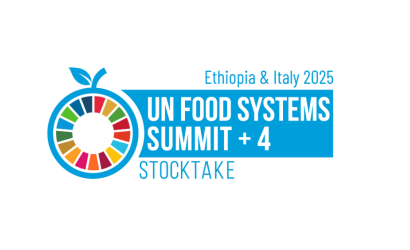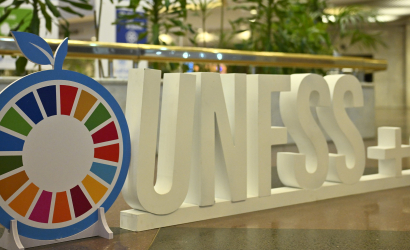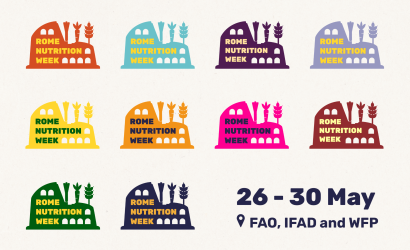Climate change is making headlines in many, if not most, newspapers around the world and all countries face nutrition problems of some sort. Do climate change and nutrition have more in common than their universality? This interview examines the nexus between nutrition and the environment.
In addition to climate change, Martina Otto of the United Nations Environment Programme (UNEP) highlights other aspects of the triple planetary crisis and their interplay with diet. Martina has worn many hats in UNEP. She currently heads the Climate and Clean Air Coalition Secretariat, and formerly served as the UNEP representative on the UN-Nutrition steering committee. Drawing on the findings from a new UN-Nutrition discussion paper, Nutrition and the Environment – Nurturing people, protecting the planet, she explains how a sustainable food systems approach and healthy diets are essential for our own nutrition and welfare, as well as the future of our planet. Martina also gives a glimpse at what measures can be taken towards shared goals, underscoring the urgency for nutritionists, environmentalists and other food system actors to unite to protect the vulnerable and abate further damage. The discussion paper profiled in this interview is just one way that UN-Nutrition is seeking to build bridges across sectors within and beyond the UN System in pursuit of co-benefits for nutrition and the environment.
Q1: In your opinion, why was it important to develop this discussion paper on the interlinkages between nutrition and the environment? What prompted UNEP to collaborate with UN-Nutrition on the development of this paper?
Martina: Nutrition and the environment, for too long had been looked at as a matter of trading off one with the other. It was high time to zoom in on interlinkages – not least [because] nutrition security is directly dependent on a healthy environment. At the same time, our present food systems put pressure on their very base with the 34 percent of greenhouse gas emissions that the sector accounts for, or the huge impact on water use and pollution, or land use change. Zooming in on diets and sustainable food systems was a very logical place to look for solutions at the nexus of nutrition and environment. And solutions exist at all stages of food systems. For example, when we look at production systems, introducing or reintroducing locally appropriate indigenous, neglected and underutilized species, or techniques such as alternate wet and drying in rice production. In getting foods to market, ensuring appropriate cold chains can reduce food loss. At the retail, hospitality and household level, avoiding food waste is crucial. The food that is not feeding people is feeding climate change, and de facto is a triple loss: for food and nutrition security, economically, including all the resources that went into producing it, and the methane emissions that come from organic waste spurring climate change.
In previous roles at UNEP, I have been working with UN Energy and hence knew about the power of connecting UN agencies that work on the same topic, with their respective angles and mandates, around a joint agenda and workplan. Key agencies were already working together under UN-Nutrition, facilitating multi-agency coordination and cooperation, yet all coming from a food or health background. Given the importance of environmental aspects for food systems transformation, it was only logical to join in.
Q2: With more and more actors turning their attention to the nutrition-environment nexus, what is novel about this paper?
Martina: Indeed, there is a growing recognition of the nutrition-environment nexus, and a growing community of actors embracing it. Yet, three things are key and (still) novel: (1) taking a food systems perspective to actively seek multiple benefits; (2) acknowledging that much focus has been put on the production systems while too little focus has been put on the consumption side and promoting behavioural changes; and (3) that to get the job done, we require the cooperation of different parts of the food value chain and across levels of governance. We hope that the new discussion paper inspires new alliances between different actors along the value chain, to transform present systems.
Q3: The discussion paper outlines various policy recommendations and other measures that can be taken to promote healthy and environmentally friendly diets at each food systems stage. It also underscores the need for context-specific, equity-sensitive, multisectoral solutions. Tell us a bit about how the United Nations Environment Programme (UNEP) will apply the findings of the paper to its work and operations?
Martina: Food systems are a high impact sector for UNEP. In our work, we pursue a vision of sustainable food systems, where they contribute to the integrity of biodiversity and ecosystems, promote climate stability and a pollution-free planet, while enabling healthy diets and good nutrition for all people, and ensuring livelihoods of farmers. The findings of the paper are rallying points, which will help us to strengthen our efforts in promoting sustainable food consumption patterns, supported by other areas of UNEP interventions such as in sustainable lifestyles, public food procurement, urban agriculture, nature-positive agriculture, food loss and waste, and multi-stakeholder governance. Furthermore, connecting the different communities spurs ever closer collaboration with other UN-Nutrition members, including at the country level through the UN country teams. This will also help translate the findings to context-specific, equity-sensitive, and multisectoral solutions.
Q4: What advice (1-3 tips) do you have for countries/municipalities/cities who are trying to bring the environmental, nutrition, agriculture and health communities together to tackle these interlinked challenges? How can UN-Nutrition facilitate knowledge exchanges between them to promote peer learning in this area?
Martina:
- Invest in education and information backed by technical studies with context-based food systems data. This would not only help create awareness among different food systems communities on how environmental degradation is threatening food and nutrition security and vice-versa, especially how this is happening in their geographic areas, but also enable evidence-based decision-making. Let me add to this, there has been a lot of focus on ecosystem adaptation not being able to keep up with the pace of climate change and thereby negatively impacting agriculture outputs. But also, air pollution as well as so-called short-lived climate pollutants such as methane and tropospheric ozone bring home the interrelation of production systems, food loss and waste and impacts on people’s health and plant growth.
- Invest in governance structures that allow multistakeholder collaboration. Food systems are complex and only by connecting environmental, nutrition, agriculture and health communities can we truly transform present systems. This is not trivial, as we all speak different languages (not only literally) and come with different primary objectives. But there are examples that show the benefits of investments in multi-level governance; UN-Nutrition can play an important role in spreading these best practices.
- And since you asked about the country/city linkages, let me add the importance of addressing the rural-urban divide, and investing in peri-urban as well as urban agriculture as part of the mosaic of solutions.
Q5: Several UN-Nutrition Member Agencies, including UNEP, are part of the Coalition of Action on Healthy Diets from Sustainable Food Systems for Children and All (HDSFS). How can the findings from this paper be used in the follow-up from the UN Food Systems Summit to ensure that food system transformation is working for better nutrition and a better environment?
Martina: The findings of this paper can inform the follow-up from the UN Food Systems Summit, particularly the upcoming Stocktaking Moment in July 2023, to ensure that country-level support to food system transformation is working for better nutrition and [a] better environment. Putting diets at the nexus between food systems, environment and nutrition, the policy options and methodologies provided in the paper can further inform efforts of the HDSFS coalition. One example is how to integrate environmental considerations into food-based dietary guidelines. Other examples are the School Meals Coalition, Food is Never Waste and the Urban Food Systems Coalitions, all three emphasizing food consumption patterns as driver of change. This is a primary area where the nexus directly speaks to individuals, where each and every one of us can take charge, supported by advice from nutrition and health actors.



